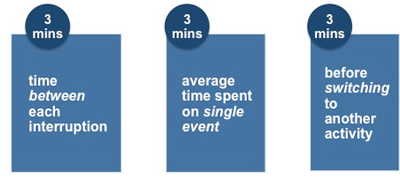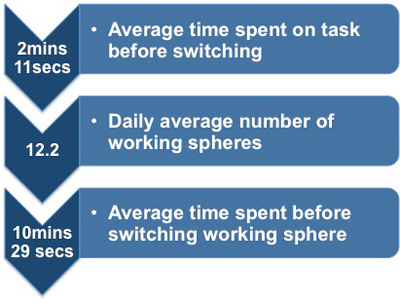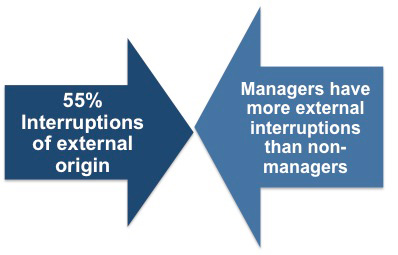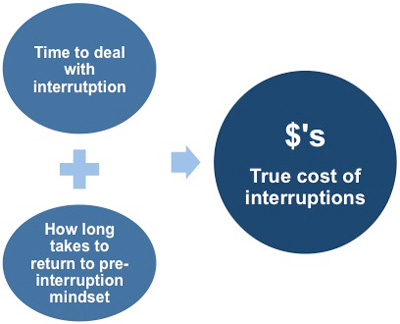Handling Interruptions at Work
According to research undertaken by Gloria Mark, Ph.D., associate professor at the Donald Bren School of Information and Computer Sciences at the University of California, people can expect to be interrupted about once every three minutes.
Reference - Dabbish, L., Mark, G., and Gonzalez, V. (2011). Why Do I Keep Interrupting Myself?: Environment, Habit and Self-Interruption. Proceeding of the twenty-ninth annual SIGCHI conference on Human factors in computing systems (CHI 2011). ACM Press, Vancouver, B.C.
To arrive at this figure Dr. Mark and her team shadowed 36 managers, financial analysts, software developers, engineers, and project leaders for three days. They followed their subjects around during a working day and timed every event.
 |
This study found that the average amount of time people spent on any single event before being interrupted or before switching tasks was about three minutes. This figure does not include time spent in formal meetings as it was assumed that people have limited control over their own productivity in this environment.
This study defined 'an event' as the amount of time that people spent in continuous, uninterrupted use of a device or a document, or in an interaction with another person. Another area that this study investigated was how often people switched the focus of their work between unrelated tasks. The researchers chose the term 'working sphere' to describe an area of work where there was a common goal, a certain group of people, or other resources involved as well as its own timeframe or deadline. All of the events that were observed were assigned to a certain working sphere.
The results of this study showed that:
 |
Even ignoring all interruptions that were two minutes or less, people only worked an average of 12 minutes and 18 seconds in a working sphere before switching.
One of the most interesting results of these findings is that people interrupted themselves almost as often as they were interrupted by external factors.
 |
This suggests that either people are not particularly good at concentrating on one area of work for extended periods, or that procrastination may be a problem and people may be seeking respite from work that they find demanding.
If these periods without interruption seem unbelievably short, then you should spend some time surreptitiously watching how often people check their iPhone or BlackBerry for incoming emails and text messages. Even when people don't pick up a separate device, they are usually working on a computer with Web access where the temptation of FaceBook , email, news pages, and other Internet distractions are only a mouse click away.
It is possible, then, that by reducing the number of longer interruptions, if even only slightly, people would be able to work on the same task for 20-30 minutes at a time, which is regarded as the optimal time to spend on a single task.
The True Cost of Interruptions
The cost of these interruptions is twofold: firstly, the time it takes to deal with the interruptions themselves, which is easily quantifiable; and secondly, the cost of how long it takes you to return to the mindset you had before you were interrupted, which is often overlooked.
 |
It is this 'double hit' on your valuable time that is most destructive to your productivity and is why you should adopt working practices that enable you to reduce your exposure to them. However, it is not possible to negate all interruptions, as often many are unavoidable and are a natural part of the 'real world' in which you work.
There are a variety of ways you can avoid the guilt often associated with avoiding interruptions and one of the most effective is creating a 'screen' that allows you to work undisturbed. The type of screen you will use varies according to how long you require total focus on a particular task and according to your organization or department.
The types of screens you can use are:
• Secretarial - someone who can take your messages.
• Put your cell phone onto silent - no vibration or ringing.
• Turn off your email or messaging service bleeper.
• Find a quiet area to work outside of your usual one.
Whichever type of screen you use, it is essential that you inform those who would have otherwise interrupted you of when you are available to them. The screening method must not be used as a task-avoidance strategy!
The frequency and length of these 'protected' times will have to be carefully planned so that you don't create bottlenecks for those needing access to your time, otherwise you will create a new problem which will further erode your productivity.
You may also be interested in:
Controlling Interruptions | Identifying Interruptions | Limiting Inappropriate Socializing | Techniques to Minimize Interruptions | Managing Phone Interruptions | Cold Call Elimination | Managing Your Outbound Calls | How to Stop Constantly Checking Emails.



